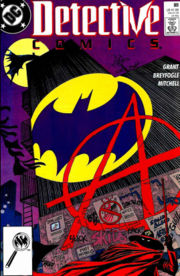
Batman is a superhero appearing in American comic books published by DC Comics. The character was created by artist Bob Kane and writer Bill Finger, and debuted in the 27th issue of the comic book Detective Comics on March 30, 1939. In the DC Universe continuity, Batman is the alias of Bruce Wayne, a wealthy American playboy, philanthropist, and industrialist who resides in Gotham City. Batman's origin story features him swearing vengeance against criminals after witnessing the murder of his parents Thomas and Martha, a vendetta tempered with the ideal of justice. He trains himself physically and intellectually, crafts a bat-inspired persona, and monitors the Gotham streets at night. Kane, Finger, and other creators accompanied Batman with supporting characters, including his sidekicks Robin and Batgirl; allies Alfred Pennyworth, James Gordon, and Catwoman; and foes such as the Penguin, the Riddler, Two-Face, and his archenemy the Joker.

Gotham City, or simply Gotham, is a fictional city appearing in American comic books published by DC Comics, best known as the home of the superhero Batman and his close allies. The city was first identified as Batman's place of residence in Batman #4 and has since been the primary setting for stories featuring the character.

Robin is the alias of several fictional superheroes appearing in American comic books published by DC Comics. The character was originally created by Bob Kane, Bill Finger, and Jerry Robinson, to serve as a junior counterpart to the superhero Batman. The character's first incarnation, Dick Grayson, debuted in Detective Comics #38. Conceived as a way to attract young readership, Robin garnered overwhelmingly positive critical reception, doubling the sales of the Batman titles. Robin's early adventures included Star Spangled Comics #65–130 (1947–1952), the character's first solo feature. He made regular appearances in Batman-related comic books and other DC Comics publications from 1940 through the early 1980s, until the character set aside the Robin identity and became the independent superhero Nightwing. As a team, Batman and Robin have commonly been referred to as the Caped Crusaders and the Dynamic Duo.
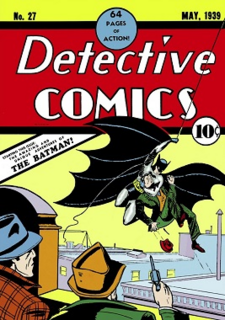
Detective Comics is an American comic book series published by Detective Comics, later shortened to DC Comics. The first volume, published from 1937 to 2011, is best known for introducing the superhero Batman in Detective Comics #27.

Alan Grant is a Scottish comic book writer known for writing Judge Dredd in 2000 AD as well as various Batman titles from the late 1980s to the early 2000s. He is the co-creator of the characters Anarky, Victor Zsasz, and the Ventriloquist.

Victor Zsasz, also known as Mr. Zsasz or simply Zsasz, is a supervillain appearing in comic books published by DC Comics. The character first appeared in Batman: Shadow of the Bat #1. He is a sadomasochistic and psychopathic serial killer who carves a tally mark onto himself for each of his victims. A recurring adversary of the superhero Batman, Zsasz belongs to the collective of enemies that make up Batman's rogues gallery.

Anarky is a supervillain appearing in comic books published by DC Comics. Co-created by Alan Grant and Norm Breyfogle, he first appeared in Detective Comics #608, as an adversary of Batman. Anarky is introduced as Lonnie Machin, a child prodigy with knowledge of radical philosophy and driven to overthrow governments to improve social conditions. Stories revolving around Anarky often focus on political and philosophical themes. The character, who is named after the philosophy of anarchism, primarily espouses anti-statism and attacks capitalism; however, multiple social issues have been addressed through the character, including environmentalism, antimilitarism, economic inequality, and political corruption. Inspired by multiple sources, early stories featuring the character often included homages to political and philosophical texts, and referenced anarchist philosophers and theorists. The inspiration for the creation of the character and its early development was based in Grant's personal interest in anti-authoritarian philosophy and politics. However, when Grant himself transitioned to the philosophy of Neo-Tech, developed by Frank R. Wallace, he shifted the focus of Anarky from a vehicle for social anarchism and then libertarian socialism, with an empasis on wealth redistribution and critique of crony capitalism, to a Neo-Tech economy.

Timothy Jackson Drake is a fictional superhero appearing in American comic books published by DC Comics, commonly in association with the superhero Batman. Created by Marv Wolfman and Pat Broderick, he first appeared in Batman #436 as the third character to assume the role of Batman's crime-fighting partner Robin. Following the events of Batman: Battle for the Cowl in 2009, Drake adopted the identity of Red Robin. In 2019, Tim returned to his original Robin persona, and had a brief stint in which he used the mononym "Drake".
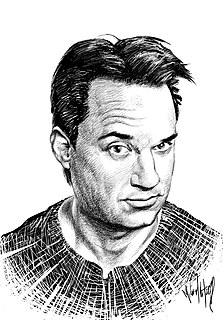
Norman Keith Breyfogle was an American artist, best known for his comic book art on DC Comics' Batman franchise from 1987 to 1995. During this time, he co-created the villains Ventriloquist and Ratcatcher with writers Alan Grant and John Wagner, and the characters Anarky, Jeremiah Arkham, Victor Zsasz, and Amygdala with Grant alone. He co-created with writers Gerard Jones and Len Strazewski the Malibu Comics Ultraverse flagship hero Prime, and both wrote and drew the Malibu-published series featuring his original character Metaphysique.
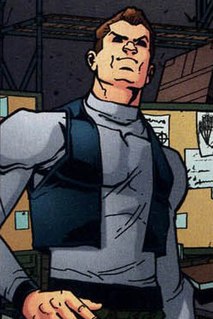
General is a fictional character appearing in American comic books published by DC Comics. Created by Chuck Dixon as an adversary of Batman, the character first appeared in Detective Comics #654, published in December 1992. Named for the character's gimmick for military strategy and prowess with small arms, stories involving the character often include historic military references and themes.

Ratcatcher is a fictional character appearing in American comic books and other media published by DC Comics, primarily as an enemy of Batman. He belongs to the collective of adversaries that make up the Dark Knight's rogues gallery. Once an actual rat-catcher in Gotham City, Flannegan sank into a life of crime. Calling himself the Ratcatcher because of his special ability to communicate with and train rats, Flannegan has used his minions to plague Gotham on more than one occasion by unleashing hordes of the vermin.

Batman is an ongoing American comic book series featuring the DC Comics superhero Batman as its main protagonist. The character, created by Bob Kane and Bill Finger, first appeared in Detective Comics #27. Batman proved to be so popular that a self-titled ongoing comic book series began publication with a cover date of spring 1940. It was first advertised in early April 1940, one month after the first appearance of his new sidekick, Robin the Boy Wonder. Batman comics have proven to be popular since the 1940s.
Alan Brennert is an American author, television producer, and screenwriter. Brennert has lived in Southern California since 1973 and completed graduate work in screenwriting at the University of California, Los Angeles.

Anarky was a short-lived American comic book series published by DC Comics, as a limited series between May and August of 1997, and as an ongoing series between May and December of 1999. It was written by Alan Grant, with pencils by Norm Breyfogle, and inks by Josef Rubinstein. The comic was a spin-off title derived from the Batman franchise, and followed the adventures of Anarky, an antagonist of the Batman character.

Batman: Anarky is a 1999 trade paperback published by DC Comics. The book collects prominent appearances of Anarky, a comic book character created by Alan Grant and Norm Breyfogle. Although all of the collected stories were written by Alan Grant, various artists contributed to individual stories. Dual introductions were written by the creators - both of whom introduce the character and give insight into their role in Anarky's creation and development.

"The Last Arkham" was a four-part Batman story arc that started the Batman: Shadow of the Bat comic book series in mid-1992. The storyline began in Batman: Shadow of the Bat #1, and finished in Batman: Shadow of the Bat #4. DC Comics later compiled the four issues into a trade paperback in 1995. The comic was written by Alan Grant and drawn by Norm Breyfogle and was responsible for the introduction of several new characters into the Batman universe.
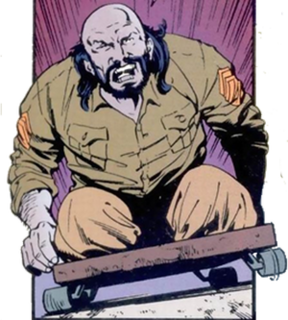
Legs is a fictional character in the DC Comics Universe who appeared as a supporting character in various Batman-related comics during the 80s and 90s. Co-created by writers John Wagner and Alan Grant, and artist Norm Breyfogle, he first appeared in Detective Comics #587.
The publication history of Anarky, a fictional character appearing in books published by DC Comics, spans various story arcs and comic book series. Co-created by Alan Grant and Norm Breyfogle, he first appeared in Detective Comics #608, as an adversary of Batman. Introduced as Lonnie Machin, a child prodigy with knowledge of radical philosophy and driven to overthrow governments to improve social conditions, stories revolving around Anarky often focus on political and philosophical themes. The character, who is named after the philosophy of anarchism, primarily espouses anti-statism. Multiple social issues have been addressed whenever the character has appeared in print, including environmentalism, antimilitarism, economic exploitation, and political corruption. Inspired by multiple sources, early stories featuring the character often included homages to political and philosophical books, and referenced anarchist philosophers and theorists. The inspiration for the creation of the character and its early development was based in Grant's personal interest in anti-authoritarian philosophy and politics. However, when Grant himself transitioned to the philosophy of Neo-Tech, he shifted the focus of Anarky from a vehicle for socialist and populist philosophy, to rationalist, atheist, and free market-based thought.
Jeremiah Arkham is a fictional supervillain and the head of the Arkham Asylum in DC Comics, created by Alan Grant. Arkham was created in 1992 and became the second villain to take up the mantle of the Black Mask. Arkham slowly "lost his mind" during his time in the Asylum, subsequently becoming the second Black Mask. Though described as a sadist, Arkham seems to believe his intentions are for the benefit of his patients.
